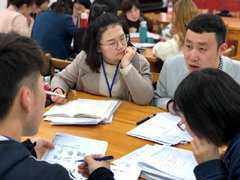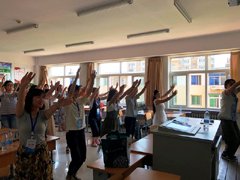Training Workshop for Japanese-Language Teachers at Secondary Schools Nationwide
THE Japan Foundation, Beijing
WANG Chongliang, TAKASAKI Sachiyo, FUJII Mai, URAI Satoshi
In spring and summer every year since 2003, The Japan Foundation, Beijing has been co-hosting a training workshop for Japanese-language teachers at secondary educational institutions nationwide with the Japanese language course material research and development center at the Curriculum and Teaching Materials Research Institute (CTMRI), People's Education Press(hereinafter the “PEP”). The workshop had been being held in Beijing in the summer and a regional school in the spring, but from 2018 it began being held at regional schools in both summer and spring. The training covers Japanese-language teachers at secondary educational institutions, and is the only such workshop in China held on a national scale.
In an average year, each workshop attracts around 60 participants, but numbers began increasing from the summer 2017 workshop, and indeed 120 people took part in the summer 2018 and spring 2019 workshops, respectively. Influenced by the university entrance exam, in recent years the number of schools that are newly establishing Japanese courses has been increasing, and the number of young Japanese-language teachers has been increasing accompanying that. Conceivably, this is behind the growing level of interest in the workshops.
Some of the themes of the lectures and workshops that have been held since the current Japanese-Language Specialists were dispatched are outlined below:
Summer 2017: “The purpose of the curriculum standards, and lesson design”
Spring 2018: “Reading comprehension classes aimed at cultivating core qualities”
Summer 2018: “Composition classes aimed at cultivating core qualities”
Spring 2019: “Guiding knowledge of the Japanese language while aiming to cultivate core qualities”
The spring workshop held in March this year focused on the theme of “Guiding knowledge of the Japanese language while aiming to cultivate core qualities.” Participants deepened their understanding of the “core qualities *2,” which are viewed as important in the new “curriculum standards *1,” and considered how to provide guidance on vocabulary and grammar while targeting that learning. Participants worked on improving their lesson plans based on things they had become aware of in the lectures or group discussions, and presented them on the final day.
| Time | Agenda | |
|---|---|---|
| March 25 (Monday) |
2 p.m.–7 p.m. | Reception, handout pick-up |
| March 26 (Tuesday) |
8:30 a.m.–9 a.m. 9:10 a.m.–10:30 a.m. 10:40 a.m.–noon |
Opening ceremony, commemorative photo Lecture 1: “Human resources training from the standpoint of the “Senior Secondary School Course Standards (2017)” Lecture 2: “Cultivating language ability from the standpoint of the Japanese-language subject’s core qualities” |
| From noon | Lunch | |
| 2:00–3 p.m. 3:10 p.m.–5:00 p.m. 5:00 p.m.–5:20 p.m. |
Lecture 3: The current state of Japanese-language education in secondary education institutions” Workshop 1: Reflecting on and sharing the pre-assigned lesson plans Introduction of the hosting organization |
|
| 5:40 p.m.–7:00 p.m. | Get-together | |
| March 26 (Tuesday) |
8:30 a.m.–10:00 a.m. 10:20 a.m.–11:50 a.m. |
Lecture 4: “Teaching vocabulary” Lecture 5: “Considering how to teach grammar” |
| From noon | Lunch | |
| 2:00 p.m.–4:00 p.m. 4:10 p.m.–5:30 p.m. |
Workshop 2: Improving the lesson plans Demonstration class |
|
| From 5:40 p.m. | Dinner | |
| March 27 (Wednesday) |
8:30 a.m.–11:00 a.m. 11:10 a.m.–12:20 p.m. |
Workshop 3: Lesson plan presentation (1) Workshop 4: Lesson plan presentation (2) |
| From noon | Lunch | |
| 2:00 p.m.–3:50 p.m. 4:00 p.m.–5:00 p.m. |
Japanese cultural experience Filling out survey, closing ceremony |
|
The workshops are held by forming small groups of three or four people and splitting up across four classrooms. As a pre-assigned task, we have participants create and submit lesson plans from designated material.
[Workshop procedure]
Workshop 1: Reflecting on and sharing the pre-assigned lesson plans
After discussing things that they became aware of and understood in Lectures 1–3, the participants individually considered points to improve in the pre-assigned lesson plans, and shared them
Workshop 2: Improving the lesson plans
Each participant improved their lesson plan based on things they noticed in Workshop 1, shared them within their group, and then continued with further improvements to create an even better lesson plan.
Workshop 3: Lesson plan presentation (1)
After making individual presentations within the group, a group representative was selected, and each group’s representative gave a presentation to the class. Following that, a class representative was selected via a vote.
Workshop 4: Lesson plan presentation (2)
Each class representative gave a presentation, and then time was set aside for questions and answers.
In this case the developed lesson plans were projected onto a screen and each participant gave a presentation, but in some cases the lesson plans are also considered in groups and poster presentations are given. As a result of discussing amongst themselves how they can realize better lessons, and through activities such as coming up with lesson plans and posters, participants are made aware of fresh perspectives they may not have been able to discover on their own.

Group discussion
In addition to lectures and workshops, demonstration Japanese-language classes taught by teachers from the school hosting the training workshop are held, and Japanese culture experiences and other activities are also held with the cooperation of JICA Japan Overseas Cooperation Volunteers Japanese-language education teams. Participants try on Yukata (Japanese summer kimono), and learn about Tanka (31-syllable poems) and Senryu (humorous poems), or actually dance the Awa Odori or Soran Bushi dance, and they seem to really enjoy themselves every time. They work proactively toward the goal of returning to their schools and actually trying out the things they experience at the training workshop with their students.

Japanese culture experience (Awa Odori)
At the spring 2019 training workshop, 85% of the participants who answered a survey said they were “very satisfied” with the training. It thus appears that we were able to offer the participants a meaningful training workshop. The number of schools establishing Japanese courses is projected to increase in the future also. Amid that, we are aware of the need to constantly consider what is required of us, and what we can offer.
| Very satisfied | Moderately satisfied | Cannot say either way | A little unsatisfied | Unsatisfied |
|---|---|---|---|---|
| 88 | 15 | 0 | 0 | 0 |
*1:The national curriculum at secondary educational institutions
*2:Education that cultivates students’ humanity, and nurtures their entire personality. This is also mentioned in the “Curriculum Standards” and is viewed as important in China.
- What We Do Top
- Arts and Cultural Exchange [Culture]
- Japanese-Language Education Overseas [Language]
- Japanese-Language Education Overseas [Language] Top
- Learn Japanese-language
- Teach Japanese-language
- Take Japanese-Language Test
- Know about Japanese-language education abroad
- The Japanese-Language Institute, Urawa
- The Japanese-Language Institute, Kansai
- Japanese-Language Programs for Foreign Specified Skilled Worker Candidates
- Japanese Language Education for Japanese Children Resident Overseas and for the Descendants of Migrants
- Archives
- Japanese Studies and Global Partnerships [Dialogue]
- JF digital collection
- Other Programs / Programs to Commemorate Exchange Year
- Awards and Prizes
- Publications
